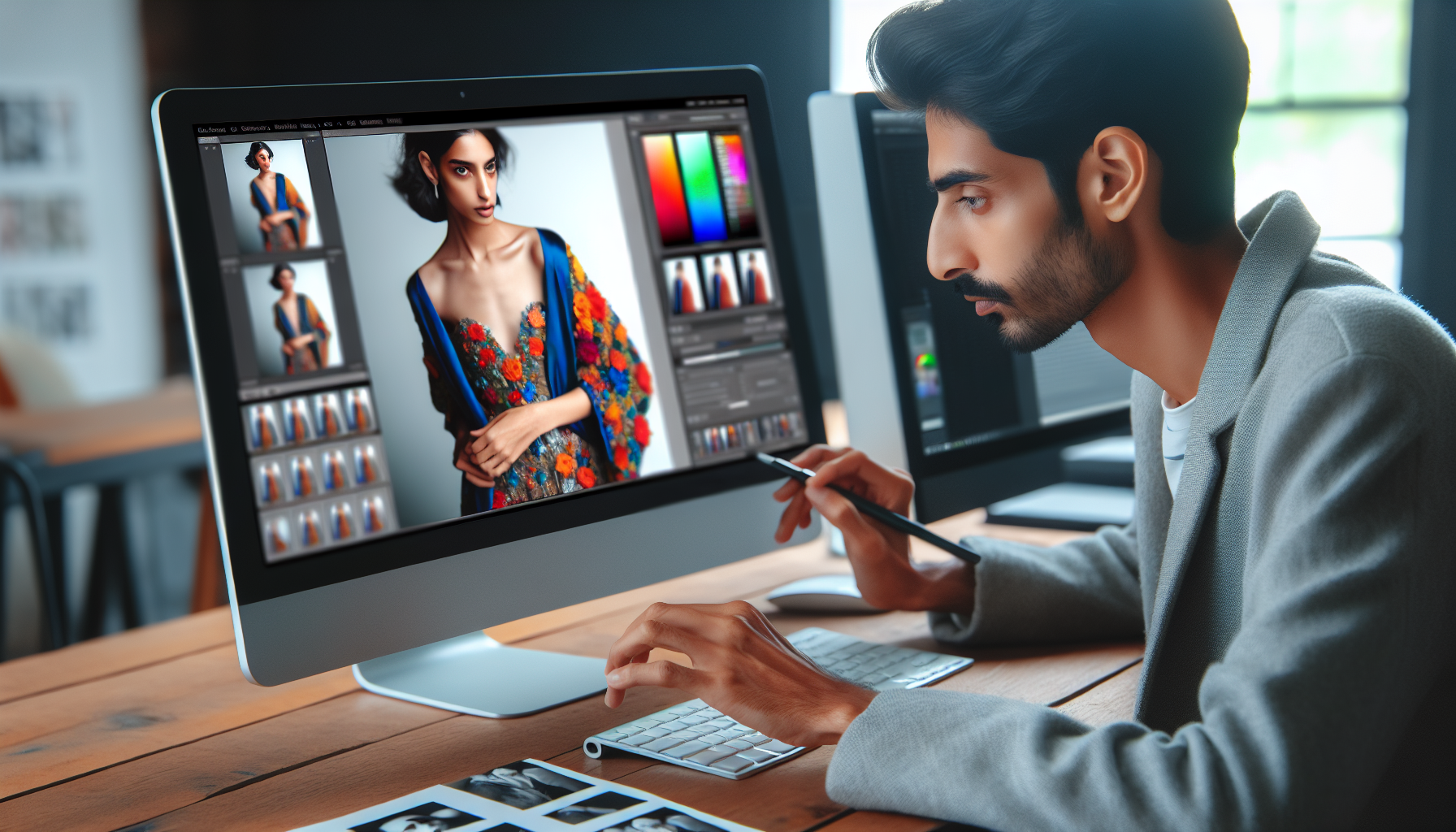
Achieving truly exceptional results in fashion photography demands a move beyond basic adjustments. It requires a deep understanding of light, shadow, color, and texture, combined with mastery of sophisticated digital tools. High-end retouching is an art form in itself, a meticulous process that elevates images to meet the exacting standards of luxury brands and discerning online shoppers. It’s about creating images that not only look flawless but also feel authentic and engaging, ultimately driving conversions and building brand loyalty.
Key Takeaways:
- Frequency Separation is essential for flawless skin and fabric retouching, maintaining texture while removing imperfections.
- Dodge and Burn techniques sculpt and refine shapes, adding depth and dimension to garments and models for a more dynamic visual impact.
- Advanced color grading creates a consistent and brand-aligned aesthetic, ensuring images resonate with the target audience and enhance product appeal.
- Non-destructive workflows using layers and masks are crucial for professional, flexible editing, allowing for iterative refinements and adjustments without compromising image quality.
- Attention to detail in areas like hair, makeup, and garment details distinguishes high-end retouching and elevates the overall image quality.
- Understanding the psychological impact of imagery on buyer behavior and aligning retouching with UX design principles is key for e-commerce success.
- Efficient workflows and tailored processes are vital for high-volume e-commerce studios, ensuring consistent quality and timely delivery for demanding clients.
Mastering Frequency Separation for Impeccable Texture
Frequency Separation is a cornerstone technique in high-end retouching, particularly invaluable for fashion photography where both model skin and garment textures need to look pristine yet natural. This method cleverly divides an image into two frequency layers: a low-frequency layer containing color and tone, and a high-frequency layer holding detail and texture. By separating these components, editors gain independent control over each, allowing for targeted adjustments without compromising the integrity of the other.
Imagine a scenario where a high-end fashion retailer needs to showcase a delicate silk blouse. Standard retouching might smooth out wrinkles, but could also inadvertently flatten the fabric’s texture, making it appear artificial. Frequency Separation offers a solution. On the low-frequency layer, editors can address color casts, smooth out tonal transitions, and remove larger blemishes or distractions on the fabric without affecting its detailed weave. Simultaneously, on the high-frequency layer, they can subtly refine texture, perhaps reducing minor fabric imperfections or enhancing the natural drape and fall of the garment, all while preserving the realistic feel of silk.
For skin retouching, Frequency Separation is equally transformative. It enables the removal of blemishes, uneven skin tones, and minor wrinkles on the low-frequency layer, resulting in a smooth, even complexion. Critically, the high-frequency layer retains the skin’s natural texture – pores, fine lines, and subtle imperfections that contribute to realism. This prevents the “plastic” or overly smooth look that is a hallmark of amateur retouching. Expert retoucher, Eleanor Vance, who has worked with leading fashion brands, notes, “Frequency Separation is non-negotiable for high-end fashion work. It’s the difference between an image that looks retouched and one that looks naturally perfect. It gives you granular control, ensuring skin looks flawless yet real, and fabric textures are enhanced without appearing fake.”
Dodge and Burn: Sculpting Light and Form

Dodge and Burn is a technique with roots in traditional darkroom photography, now meticulously translated into the digital realm. It involves selectively lightening (dodging) and darkening (burning) areas of an image to sculpt light and shadow, adding depth, dimension, and visual interest. In fashion retouching, Dodge and Burn is crucial for enhancing the shape of garments on models, accentuating curves, and creating a sense of movement and dynamism.
Consider a photograph of a model wearing a flowing evening gown. Flat, un-retouched, the dress might lack visual impact. Through Dodge and Burn, a retoucher can strategically lighten highlights on areas where light naturally catches – like the folds of fabric or the model’s cheekbones. Conversely, they can darken shadows in areas that recede, such as under the bust or along the inner curves of the dress. This careful manipulation of light and shadow creates the illusion of three-dimensionality, making the dress appear more luxurious, and the model more statuesque.
Beyond global adjustments, Dodge and Burn is invaluable for refining details. It can be used to subtly enhance muscle definition on a model, sharpen facial features, or even accentuate the texture of leather accessories. The key to effective Dodge and Burn is subtlety and precision. Overdoing it can lead to images that look heavily manipulated and unnatural. Professional retouchers often use soft brushes at low opacity, building up the effect gradually over multiple layers, constantly evaluating the image for balance and realism.
A case study example comes from a campaign for a luxury watch brand. The product shots, while technically sound, initially lacked the ‘wow’ factor. The retoucher applied Dodge and Burn to highlight the watch’s intricate details – the gleam of the metal, the facets of the gemstones, and the texture of the leather strap. By carefully sculpting the light, they transformed flat images into visually arresting representations of luxury and craftsmanship, significantly enhancing the campaign’s impact.
Color Grading: Setting the Mood and Brand Tone
Color is a powerful communicator, evoking emotions and setting the overall tone of an image. In fashion photography, consistent and sophisticated color grading is essential for establishing a brand’s visual identity and ensuring images resonate with the target audience. High-end retouching goes far beyond simple color correction; it involves nuanced manipulation of color to create a specific mood, enhance product appeal, and maintain brand consistency across all visuals.
Imagine a fashion brand known for its warm, bohemian aesthetic. Their product photography needs to reflect this. Generic color correction might simply neutralize color casts, but effective color grading will intentionally push the palette towards warmer tones – perhaps adding a subtle golden hue, enhancing the richness of earth tones in the clothing, and creating an overall feeling of warmth and inviting comfort. Conversely, a brand with a sleek, minimalist style might opt for cooler, desaturated tones, creating a sense of sophistication and understated elegance.
Advanced color grading techniques often involve using adjustment layers in Photoshop such as Curves, Color Balance, and Selective Color in combination. These tools allow for precise control over different color ranges – highlights, midtones, and shadows – as well as individual color channels. Retouchers might use color grading to subtly unify a series of images shot under slightly different lighting conditions, ensuring a consistent look across an entire e-commerce product catalog. They might also use it to enhance specific colors within an image, making a particular garment color pop or drawing attention to key details.
Expert colorist, Jamie Stern, who specializes in fashion and beauty, emphasizes the strategic role of color grading. “Color grading isn’t just about making images look ‘pretty.’ It’s about aligning the visual palette with the brand’s identity and the intended emotional response. For a luxury brand, the color grading needs to evoke sophistication and aspiration. For a more accessible brand, it might be about creating a sense of vibrancy and approachability. It’s a crucial element of visual storytelling.”
Non-Destructive Workflow: The Foundation of Professionalism

In the fast-paced and often iterative world of fashion e-commerce, flexibility and efficiency are paramount. A non-destructive workflow, built around layers, masks, and adjustment layers in Photoshop, is not just a best practice; it’s an essential requirement for professional high-end retouching. This approach ensures that original image data remains untouched, and all edits are applied as layers on top, allowing for infinite adjustments and revisions without degrading image quality.
Consider a scenario where a client, Sarah, an E-commerce Operations Manager, requests a set of product images retouched. Initially, she may approve a certain style of color grading. However, after seeing the images in context on the website, she might request a subtle shift in the color palette to better align with a new marketing campaign. With a non-destructive workflow, these changes are easily accommodated. The retoucher can simply adjust the existing color grading adjustment layers without having to redo hours of work or compromise the quality of the initial edits.
Layers are the fundamental building blocks of a non-destructive workflow. Each adjustment, whether it’s Frequency Separation, Dodge and Burn, or color grading, should be applied on its own layer. Masks further enhance flexibility, allowing retouchers to apply adjustments selectively to specific areas of an image. Adjustment layers, unlike direct image adjustments, modify the image indirectly, leaving the original pixels intact. This layered approach not only allows for easy revisions but also facilitates collaboration and quality control. If another retoucher needs to take over a project, or if the client requires specific adjustments, the layered file provides a clear and organized history of all edits, making modifications straightforward and efficient.
| Feature | Non-Destructive Workflow | Destructive Workflow |
|---|---|---|
| Flexibility | Highly Flexible | Limited Flexibility |
| Revisions | Easy and Unlimited | Difficult and Limited |
| Quality Retention | Preserves Original Quality | Degrades Quality with Edits |
| Collaboration | Facilitates Collaboration | Hinders Collaboration |
| Professional Standard | Industry Standard | Not Professional |
Attention to Detail: The Hallmarks of High-End

High-end retouching transcends technical proficiency; it’s defined by meticulous attention to detail. In fashion photography, this means going beyond the obvious adjustments and refining every element of the image to perfection. This includes subtle enhancements to hair, makeup, garment details, and even the smallest background elements. These seemingly minor refinements, when executed expertly, collectively elevate the image from good to exceptional.
Hair retouching, for instance, is often overlooked but can significantly impact the overall impression. Flyaway hairs, stray strands, or uneven volume can detract from an otherwise polished look. High-end retouching involves meticulously cleaning up stray hairs, adding subtle volume where needed, and ensuring the hairstyle complements the garment and the model’s overall look. Similarly, makeup retouching isn’t about drastically altering the makeup, but about refining it – evening out foundation, subtly enhancing eye makeup, and ensuring lip color is vibrant and perfectly applied.
Garment details demand equal attention. Wrinkles and creases, while sometimes adding character, often need to be subtly addressed to ensure the garment looks its best. This involves careful smoothing and reshaping while maintaining the fabric’s natural texture and drape. Seams, zippers, and embellishments need to be crisp and well-defined. Even background details matter. Distracting elements can be removed, backgrounds can be subtly extended or refined, and overall consistency in tone and texture between the subject and background is ensured.
Consider a close-up shot of a model wearing jewelry. Beyond skin and makeup retouching, high-end attention to detail would involve enhancing the sparkle and clarity of the gemstones, removing any dust or minor imperfections from the metal, and ensuring the jewelry is perfectly positioned and reflects light beautifully. It’s this cumulative effect of meticulous refinements across every aspect of the image that truly defines high-end retouching and justifies its premium value in the fashion e-commerce industry.
Psychological Impact and UX Considerations
High-end retouching in fashion e-commerce isn’t just about aesthetics; it’s deeply intertwined with psychology and user experience (UX). The ultimate goal of product imagery is to drive sales. Understanding how visual elements influence buyer behavior and aligning retouching strategies with UX principles is crucial for maximizing conversion rates and building customer trust.
Psychologically, consumers make snap judgments based on visual cues. High-quality, professionally retouched images instantly convey professionalism, attention to detail, and brand value. Conversely, poorly retouched or low-quality images can create a perception of cheapness or lack of care, deterring potential buyers. Studies show that shoppers rely heavily on product images to assess quality and make purchasing decisions, with up to 75% citing image quality as a critical factor.
From a UX perspective, product images are a core element of the online shopping experience. Images need to be clear, well-lit, and accurately represent the product. High-end retouching ensures color accuracy, highlighting true fabric colors and textures, minimizing discrepancies between online visuals and the physical product. Consistent image presentation across an e-commerce site creates a seamless and trustworthy browsing experience. Zoom functionality, enabled by high-resolution retouched images, allows shoppers to examine details closely, enhancing their confidence in the product.
Furthermore, retouching can subtly guide the viewer’s eye, drawing attention to key features and benefits of the product. Strategic use of Dodge and Burn, color enhancements, and detail sharpening can highlight design elements, fabric textures, or unique selling points. By understanding the psychological impact of visual elements and integrating UX considerations into the retouching process, professional editors can significantly contribute to the success of e-commerce fashion brands.
Efficiency and Tailored Processes for High-Volume Studios

While artistry and technical skill are paramount, efficiency and streamlined workflows are equally critical in the high-volume environment of fashion e-commerce retouching. Professional studios, like Pixel By Hand, catering to clients with large product catalogs and tight deadlines, must balance impeccable quality with speed and cost-effectiveness. This requires establishing tailored processes and leveraging technology to optimize every stage of the retouching workflow.
For high-volume projects, batch processing and automation play a significant role. Actions and scripts in Photoshop can automate repetitive tasks like basic color correction, background removal, and initial frequency separation setup. However, automation is not a replacement for skilled retouchers; it’s a tool to enhance their efficiency. Expert retouchers then focus on the more nuanced and creative aspects of high-end retouching, applying their skills to refine details, sculpt light and shadow, and ensure the final images meet the highest quality standards.
Tailoring processes to individual client needs is another key aspect of efficiency. Understanding each client’s brand guidelines, aesthetic preferences, and specific requirements for image types (e.g., product shots, model shots, ghost mannequin) allows studios to create customized workflows. This might involve creating preset actions and templates, establishing clear communication channels, and implementing feedback loops to ensure alignment and minimize revisions. Pixel By Hand’s proprietary online platform exemplifies this tailored approach, enabling clients like Sarah to provide precise feedback directly on images, streamlining communication and ensuring edits are perfectly aligned with their vision.
Efficient workflow management also involves careful project planning, task delegation within retouching teams, and utilization of project management tools to track progress and meet deadlines. By combining technological efficiency with tailored processes and expert human skill, high-volume studios can consistently deliver high-end retouching services that meet the demanding needs of the fashion e-commerce industry, ensuring both exceptional quality and timely delivery.
In conclusion, mastering high-end retouching techniques is an ongoing journey of learning, refinement, and adaptation. For professional editors in the fashion e-commerce space, it’s not just a skillset, but a craft that demands both technical expertise and artistic vision. By embracing advanced techniques like Frequency Separation, Dodge and Burn, and sophisticated color grading, while adhering to non-destructive workflows and prioritizing attention to detail, retouchers can elevate product imagery to new heights. Coupled with an understanding of the psychological impact of visuals and the need for efficient, tailored processes, these skills become invaluable assets in the competitive world of online fashion retail, driving sales, building brand trust, and shaping the visual landscape of e-commerce.